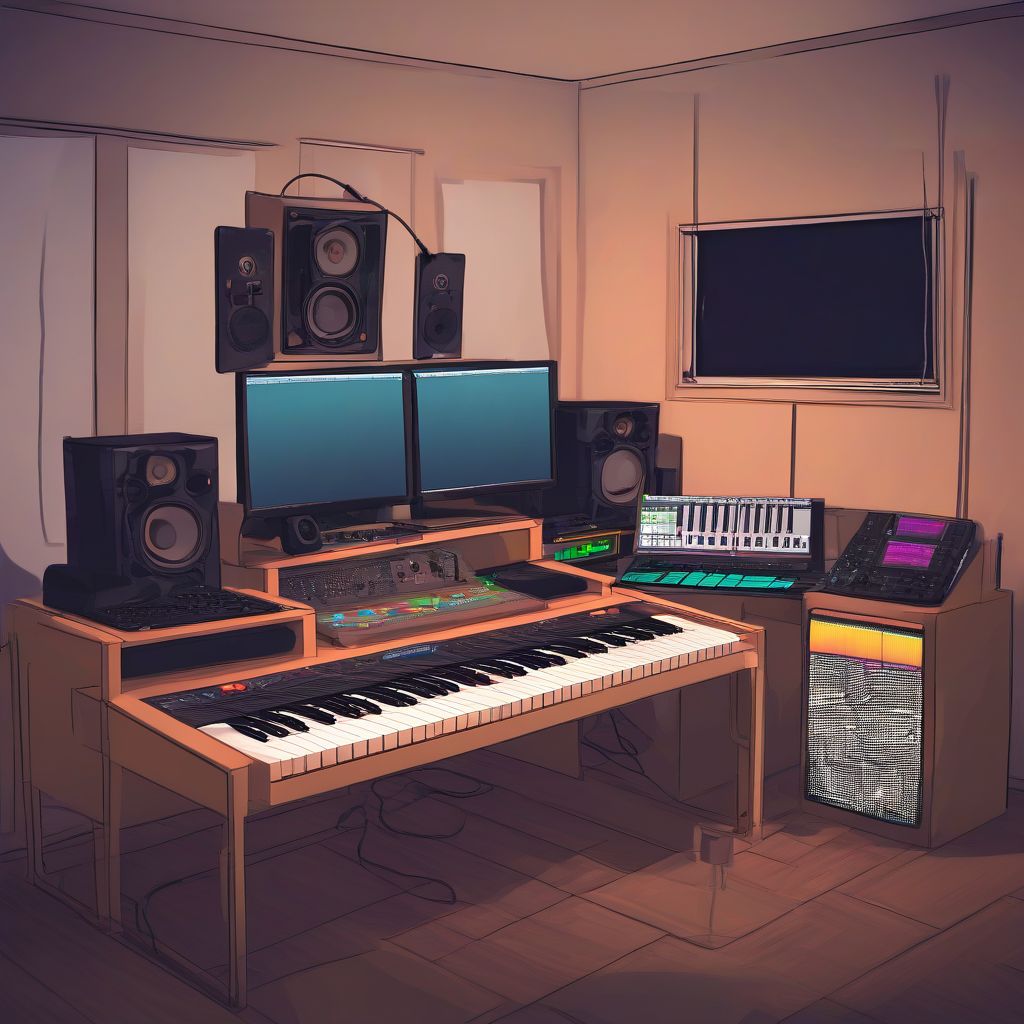Have you ever listened to your favorite song and thought, “I wish I could create something like that”? The truth is, you absolutely can! Music production might seem like magic, but with today’s technology and a little guidance, opening the door to your own sonic universe is easier than you think. This beginner’s guide will demystify the basics of music production, providing you with the tools and knowledge to start crafting your own tracks.
 Music Production Setup for Beginners
Music Production Setup for Beginners
Essential Building Blocks: Understanding the Core Components
Before diving into the exciting world of loops and melodies, let’s break down the fundamental elements of music production:
1. Digital Audio Workstation (DAW): Your Creative Hub
Think of a DAW as your musical canvas. It’s a software where all the magic happens. From recording instruments and vocals to arranging, editing, and mixing your sounds, a DAW is your command center.
- Popular DAW Choices: Ableton Live, Logic Pro X, FL Studio, Cubase, Pro Tools
- Tip: Many DAWs offer free trials or lite versions, giving you a chance to experiment before committing.
2. Audio Interface: Bridging the Gap Between Sound and Software
An audio interface acts as the translator between your instruments and your computer. It converts analog audio signals (like the sound of your guitar) into digital information your DAW can understand.
- Key Features: Microphone preamps, instrument inputs, headphone jack, and balanced outputs for studio monitors.
- Tip: Consider your budget and the number of inputs/outputs you need based on the instruments you plan to record.
3. Headphones & Studio Monitors: Your Sonic Windows
Clear and accurate audio reproduction is crucial for making informed mixing decisions. Headphones are perfect for private listening and detailed work, while studio monitors provide a more accurate representation of your mix in a room environment.
- Tip: Invest in both closed-back headphones for recording and open-back headphones for mixing and critical listening.
4. MIDI Keyboard: Your Musical Sketchpad
A MIDI keyboard doesn’t produce sound on its own; instead, it sends MIDI data (musical instructions) to your DAW, triggering virtual instruments like pianos, synths, and drums.
- Tip: Choose a keyboard size and features that align with your playing style and musical goals.
5. Microphone: Capturing Your Voice and Instruments
From vocals to acoustic guitars and drums, a microphone is essential for capturing live sound.
- Microphone Types: Dynamic microphones excel at handling high volumes, making them suitable for drums and loud vocals. Condenser microphones are more sensitive, capturing subtle nuances, ideal for vocals, acoustic instruments, and recording in quieter environments.
Your First Steps into Music Production: A Beginner-Friendly Approach
Now that you have a grasp of the basic equipment, let’s explore how to start creating music:
1. Choosing Your DAW: Finding the Right Fit
Experiment with different DAWs (remember those free trials?) and choose one that aligns with your workflow and musical preferences. Each DAW has its strengths and learning curve, so explore and find your perfect match.
2. Mastering the Basics: Building a Strong Foundation
Start by learning the fundamentals of your chosen DAW. Familiarize yourself with:
- Recording Audio: Understand how to connect and record instruments or vocals into your DAW.
- Arranging and Editing MIDI: Learn how to create drum beats, bass lines, and melodies using virtual instruments.
- Basic Mixing: Explore concepts like volume, panning (positioning sounds in the stereo field), and EQ (adjusting the tonal balance).
3. Exploring Virtual Instruments and Samples: Unleashing a World of Sounds
Most DAWs come bundled with a library of virtual instruments and samples, providing a vast palette of sounds to work with.
- Tip: Don’t be afraid to experiment with different sounds and combinations. This is where your creativity shines!
4. Embracing Online Resources and Communities: Learning from the Pros
The internet is a treasure trove of music production tutorials, courses, and communities.
- Tip: YouTube channels, online forums, and dedicated music production websites offer valuable insights, tips, and inspiration from seasoned producers and fellow beginners.
5. Finding Your Sound: Experimentation is Key
Don’t be afraid to experiment, break the rules, and develop your unique musical identity.
- Tip: Listen to your favorite artists for inspiration but don’t be afraid to deviate and explore your creative voice.
[amazon bestseller=”beginner music production”]
Conclusion: Your Musical Journey Begins Now
Music production is an ongoing journey of learning, experimentation, and, most importantly, fun! Remember, even the most acclaimed producers started with the basics. By embracing these foundational concepts, exploring the vast resources available, and, most importantly, never stopping experimenting, you’ll be well on your way to crafting music that reflects your unique artistic vision.
So, what are you waiting for? Dive into the world of music production and let your creativity soar! Share your experiences, challenges, and musical triumphs in the comments below – let’s learn and grow together.
